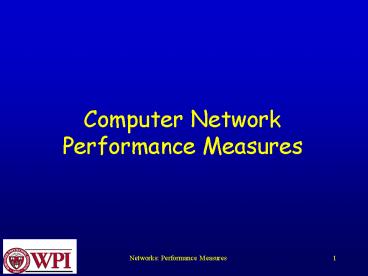Computer Network Performance Measures PowerPoint PPT Presentation
Title: Computer Network Performance Measures
1
Computer Network Performance Measures
2
W1
T
X
Z
W2
W
Y
Host L
W3
Host M
AP
Host A
W4
2
3
4
1
5
Host B
16
14
nodes
11
Host J
17
12
Host C
6
15
13
10
7
Host H
9
8
Host D
Host G
Host E
Host F
3
Simple Queuing Model
Arrivals
Server
Queue
4
Router Node
15
packet
packet
17
Outgoing Link
Server
Router Buffer
5
Performance Metrics(General Definitions)
- Utilization the percentage of time a device is
busy servicing a customer. - Throughput the number of jobs processed by the
system per unit time. - Response time the time required to receive a
response to a request (round-trip time). - Delay the time to traverse from one end to the
other in a system.
6
Network Performance Measures
- Channel utilization the average fraction of
time a channel is busy e.g. Util 0.8 - when overhead is taken into account (i.e.,
excluded from useful bits, channel utilization is
often referred to as channel efficiency - Throughput bits/sec. successfully transmitted
e.g. Tput 10 Mbps
7
End-to-end packet delay
- End-to-end delay includes multiple hop link
delays
8
End-to-end packet delay
- End-to-end packet delay the time to deliver a
packet from source to destination. - most often we are interested in the packet delay
within the communications subnet - This delay is the sum of the delays on each
- subnet link traversed by the packet. Each link
delay consists of four components - BG Bertsekas and Gallager
9
Link Packet Delay
- The processing delay PROC between the time the
packet is correctly received at the head node of
the incoming link and the time the packet is
assigned to an outgoing link queue for
transmission. - The queuing delay QD between the time the
packet is assigned to a queue for transmission
and the time it starts being transmitted. During
this time, the packet waits while other packets
in the transmission queue are transmitted.
10
Packet Delay
- The transmission delay TRANS between the times
that the first and last bits of the packet are
transmitted. - The propagation delay PROP between the time the
last bit is transmitted at the head node of the
link queue and the time the last bit is received
at the next router. This is proportional to the
physical distance between transmitter and
receiver.
11
End-to-End Packet Delay
Link packet delay PROC QD TRANS
PROP.
- end-to-end packet delay sum of ALL link packet
delays. - Be Careful !! end-to-end can be defined
- either from Host-to-Host or only within the
subnetwork.
12
End-to-end packet delay
- End-to-end delay includes multiple hop link
delays.
13
Network Performance Measures
- Latency usually implies the minimum possible
delay. Latency assumes no queuing and no
contention encountered along the path. - Goodput measured at the receiver the rate in
bits per second of useful traffic received.
Goodput excludes duplicate packets and packets
dropped along the path. - Fairness either Jains fairness or max-min
fairness are used to measure fair treatment among
competing flows. - Quality of Service a QoS measure accounts for
importance of specific metric to one type of
application e.g. jitter for streaming media.

